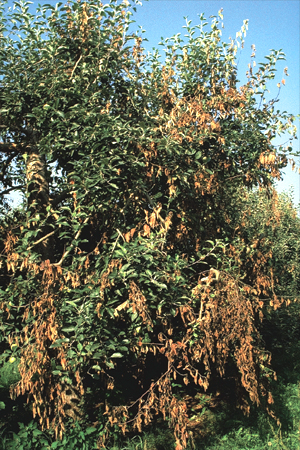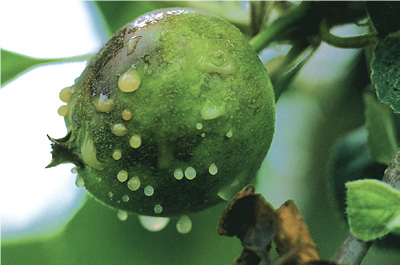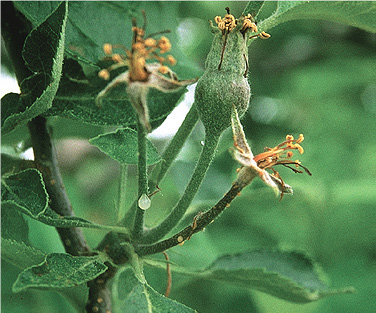Fire blight, caused by the bacterium Erwinia amylovora, is found to some extent almost every year in New Hampshire and other major apple and pear growing regions of the United States. Fire blight is one of the most destructive orchard diseases of apples and pears. In addition, because the bacterium can infect over 75 species of trees and shrubs, fire blight is also a significant disease of landscape plants including crabapple, ornamental pear, mountain ash, cotoneaster, hawthorn, firethorn, and quince. Raspberry and blackberry are also susceptible.


Jones.
Description
Fire blight is most damaging during warm (70°F), humid weather. Blossoms, twigs, leaves, and young fruit can all be infected. Symptoms include sudden wilting followed by shriveling and blackening of the blossoms and young shoots. A characteristic symptom of terminal blight is the bending of the blighted terminal to resemble a “shepherd’s crook”. The dead leaves remain attached to the twigs, giving the tree the appearance of having been scorched by fire; hence the name “fire blight”. The first symptoms are usually observed following the blossoming period. Infected blossoms shrivel, and as infections move into the twigs, the leaves on the twigs wilt and turn brown. Infected fruit turn brown (apple) or black (pear) and eventually shrivel and become mummified.
Dark, sunken cankers usually form on the larger branches. The cankers are often separated from healthy bark by narrow cracks. The cankers enlarge slowly and may eventually girdle the limb. When the bark is removed from these cankers, there is a sharp line of distinction between white healthy wood and infected reddish-brown wood. In the spring, a cream or light yellow-colored liquid may ooze from the margins of the cankers. This bacterial ooze may also be observed on young fruits or infected blossoms. Fire blight is most severe on highly susceptible varieties. (Apples: Ida Red, Fuji, Gala, Cortland, Jonathan, Jonagold, Lodi, R.I. Greening, Paula Red, Rome, and many crabapple varieties. Pears: Most pear varieties are susceptible: Bartlett, Aurora, Bosc, Anjou, Clapp’s Favorite, and several Asian cultivars. Seckel is somewhat resistant.)

Disease Cycle
The bacterium overwinters in the live bark at the edge of the cankers on the trunk or branches. During warm, moist weather in the spring, sticky, amber-colored droplets containing millions of bacteria ooze from the cankers. The bacteria may be spread to blossoms, twigs, and branches by splashing rain, insects, and pruning tools. Bacteria infect through wound or natural openings. Although bloom is the most critical time for infections, infections can occur from May – July, and into late August. Injuries to leaves and twigs caused by hail provide wounds for infections. Symptoms may be evident within a week of infection, particularly on wounded fruits. Warm (75°F-82°F), humid (> 60%) or rainy weather in the spring and summer favors repeated disease cycles and increases disease severity. Outbreaks can also occur after damaging events like hail and strong winds storms.

Jones.
Management
Fire blight damage is best reduced by a combination of sanitation, resistant varieties/species, and dormant chemical applications. In some production situations, chemical sprays may be needed during the growing season. Control of the blossom infection phase is the key to the control of subsequent secondary infection. Without blossom infection there is little opportunity for the bacteria to increase sufficiently to cause significant shoot infection.
IPM Strategies:
- Cultural Practices - Practices that favor succulent growth and production of blossoms favor development of fire blight. Fertilization should be carefully regulated to prevent succulent growth and overproduction of shoots. Avoid excessive nitrogen fertilization.
- Mechanical Control - On young trees, during dry weather, remove and burn infected twigs as soon as they are detected, especially in early summer. Make the cut at least 8-12 inches below the edge of the infected area or canker; sanitize cutting tools after each cut with a disinfectant to avoid further spread of the bacteria. A 10% household bleach solution (one part bleach to 9 parts water; thoroughly rinse and oil tools after sanitizing), or a 70% denatured (rubbing) alcohol make satisfactory sanitizers. Prune remaining cankered branches during the dormant season. Severely infected young trees may also need to be removed. Neglected or abandoned apple, pear, quince, or other susceptible species in the area should be removed.
During the winter or early spring before growth resumes, prune and burn all infected branches and twigs from the previous year, making cuts 4-6 inches below the lower edge of the canker or infected twig.
- Genetic Control - Use resistant varieties whenever possible. Apple: Liberty, Snowsweet, and Haralson are resistant; Honeycrisp and Zestar are moderately resistant. Pear: Harrow, Delight, Magness, and Moonglow are resistant. Resistant species and varieties are available for many landscape ornamentals.
Consult your county Extension Educator or state Specialist for specific pesticide recommendations.

on the lower right and droplets of bacterial ooze. Credit: W.G. Bonn.

Stop! Read the label on every pesticide container each time before using the material. Pesticides must be applied only as directed on the label to be in compliance with the law. All pesticides listed in this publication are contingent upon continued registration. Contact the Division of Pesticide Control at (603) 271-3550 to check registration status. Dispose of empty containers safely, according to New Hampshire regulations.
Download the resource for the complete factsheet.


